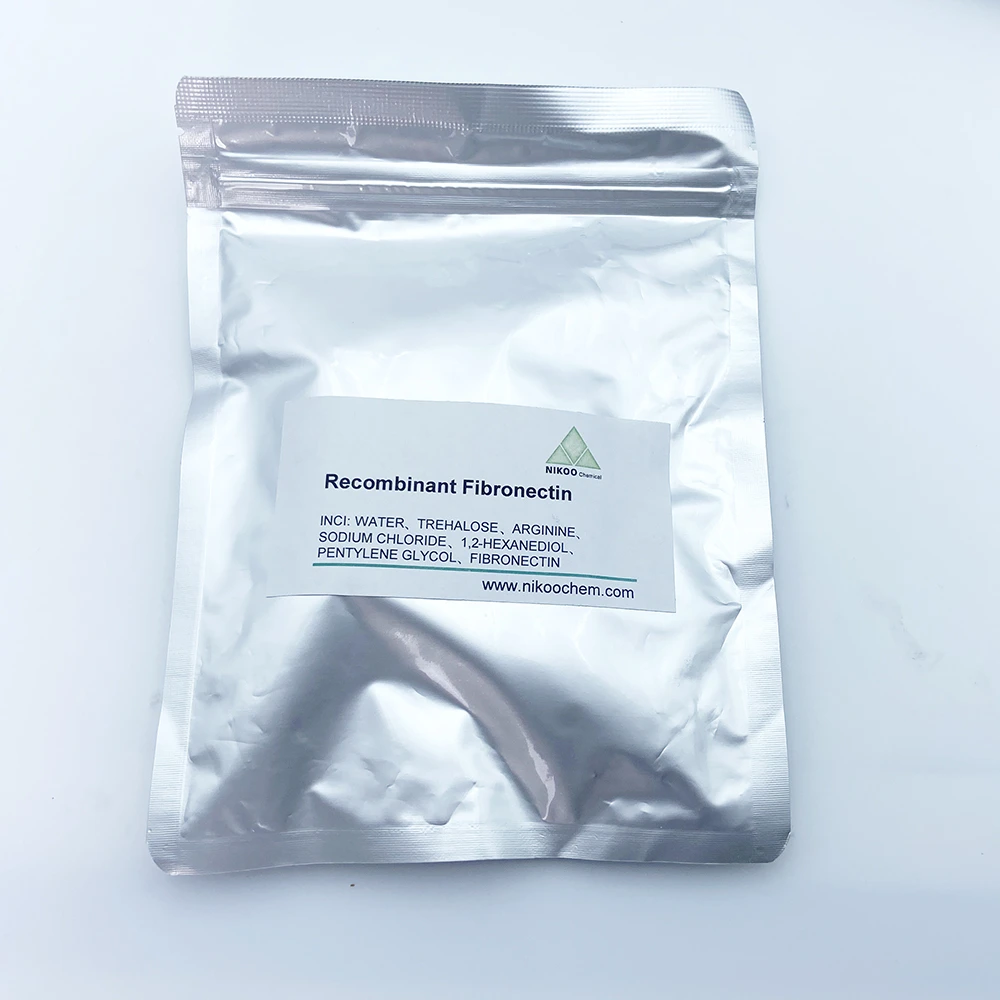Fibronectin Collagen Soothing Acne Marks Removal Repair Sensitive Skin Water Soluble
INCI No. : Aqua、TREHALOSE、ARGININE、SODIUM CHLORIDE、1,2-HEXANEDIOL、PENTYLENE GLYCOL、FIBRONECTIN
Place of Origin: Guangdong, China
Usage: Cosmetic Raw Materials, Anti-aging products, Moisturizers, Skin Repair Products
Product Names: Recombinant fibronectin,Fibronectin,Laminin,Extracellular matrix,ECM,
Appearance:
Lyophilized Powder:white or light yellow loose body, after adding sterile deionized water or PBS quickly re-soluble into a clear liquid.
Original Liquid:Clarified liquid.
Brand Name: NIKOO
Model Number: Recombinant fibronectin
Grade: Comestic Grade
Packaging Details: 1kg/bottle or 100g/bag
Product Characteristics
Fibronectin (FN), a macromolecular extracellular membrane protein present on the surface of many animal cells, is the major non-collagenous glycoprotein in the extracellular matrix and basement membrane. It plays a central role in cell adhesion and regulates cell polarity, differentiation and growth. It can be cleaved into several structural domains by restricted proteolysis, and can bind to hemofibrillar proteins, heparin, collagen, DNA, and cell surface receptors. It promotes skin cell growth, differentiation and migration, helps orderly skin regeneration, enhances barrier protein expression, repairs the skin barrier and improves the skin's self-protection ability.
Fibronectin (FN), also known as fibronectin, is a broad-spectrum, natural cell adhesion factor. Fibronectin is a 440-500 kDa dimeric glycoprotein consisting of two similar 220-250 kDa subunits linked by disulfide bonds. It exists mainly in two forms, soluble form and insoluble form, the former as a dimer in plasma and the latter old as a multimer in the extracellular matrix (ECM) and cell surface. The primary function of fibronectin is related to cell adhesion to the extracellular matrix, and the recognition of cell-associated transmembrane integrin receptors through a sequence on fibronectin called Arg-Gly-AspSer (RGDS) thereby regulating adhesion. Other structural domains of fibronectin are also involved in this adhesion process, which may involve interactions with collagen, heparin and other cell surface mucopolysaccharides. The conformation and orientation of fibronectin after adhesion is also important and plays a role in cell distribution and the strength of endothelial cell adhesion. Fibronectin-coated culture vessels used to culture BHK, CHO, and other cell lines showed more pronounced adhesion effects, and it can be argued that fibronectin is involved in numerous physiological processes in vivo, such as intercellular adhesion and migration, cytoskeleton assembly, tyrosine phosphorylation, and tumor metastasis.
Product Specification
|
Item |
Specification |
|
Model No. |
Recombinant fibronectin |
|
Sieve Analysis |
100% pass 80 mesh |
|
Appearance(25℃) |
White Powder |
|
Smell |
Odorless |
| Loss on Drying | 5% Max |
|
Sulphated Ash
|
5% Max |
| Extract Solvent | Ethanol & Water |
| Heavy Metal | 5ppm Max |
| As | 2ppm Max |
| Residual Solvents | 0.05% Max. |
| Total Plate Count | 1000/g Max |
| Yeast & Mold | 100/g Max |
| E.Coli | Negative |
| Salmonella | Negative |
|
Storage conditions |
Store in cool & dry place, Keep away from strong light and heat. |
Product Application
Fibronectin (FN) has multiple functional domains, which can bind to a variety of cell surface receptors, matrix components, etc., and through synergistic interactions with collagen, integrins, growth factor (GF) and other cells and proteins, regulate cell migration, adhesion, proliferation and other behaviors, as well as participate in the regulation of a variety of other cellular activities. These characteristics give fibronectin a wide range of effective and extensive functions, including repair, reconstruction and regeneration of tissues, induction of collagen expression and synthesis in the extracellular matrix, maintaining the stability and integrity of the extracellular matrix structure (ECM). These properties give fibronectin a wide range of functions, including repair, reconstruction and regeneration of tissues, induction of collagen expression and synthesis in the extracellular matrix, and maintenance of the stability and integrity of the extracellular matrix structure (ECM).
FN at a concentration of 0.05% can effectively promote the repair at the cellular level, and shows excellent wound healing effect in cellular scratches. This indicates that FN has a good repairing effect
It can smooth and firm the skin, remove toxins, hide pores, smooth fine lines adjust the penetration, penetrate into the bottom of the skin to remove harmful substances, improve the repair power, repair the bottom of the skin deeply and gently, gradually improve the damaged skin, improve the damage problem, improve the damage problem of the bottom of the skin, and enhance the skin vitality. Allantoin can open the skin channel, enhance the skin's water binding force, and increase the subsequent skin absorption.
Packaging
1kg/bottle, 100g/bag according to customers' requirements
For samples, it is shipped by express , such as FedEx,DHL,TNT& UPS, it takes around 3-7 days. For bulk order, we will recommend to ship by sea. If you have cooperated shipping agent in China , we can ship to their warehouse for you.
If used for pure type III collagen lyophilized powder recommended additive amount: 10-50%, other types such as emulsions, creams, sprays and other products recommended additive amount: 0.1-5%.
It is recommended that its package is light-avoidance closed package to reduce contact with air and light sources, sealed storage, and pay attention to reasonable sun protection.
Storage: room temperature (5-25 ℃) to save sealed, shaded cool place to save, 4-5 ℃ refrigeration is preferred. After opening, wipe the bottle clean and store it in airtight refrigerated storage, it is recommended to use it up within 1 month after opening.
Shelf life: the product can remain stable for at least two years when stored in closed containers under the recommended conditions.
faq

